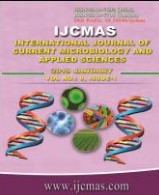


 National Academy of Agricultural Sciences (NAAS)
National Academy of Agricultural Sciences (NAAS)

|
PRINT ISSN : 2319-7692
Online ISSN : 2319-7706 Issues : 12 per year Publisher : Excellent Publishers Email : editorijcmas@gmail.com / submit@ijcmas.com Editor-in-chief: Dr.M.Prakash Index Copernicus ICV 2018: 95.39 NAAS RATING 2020: 5.38 |
The eye may be infected from external sources or through intraocular invasion of microorganisms carried by the blood stream. The common eye infections caused by bacterial and fungal pathogens are blepharitis, conjunctivitis, internal and external hordeolum, keratitis, dacryocystitis. Timely institution of appropriate therapy must be initiated to control the infections and thereby minimize the ocular morbidity. Objectives: To study the prevalence of Bacterial and Fungal etiology of External ocular infections and to study the antibiotic susceptibility Pattern of the isolated bacterial pathogens. This study was carried out at Chettinad Hospital & Research Institute. A total of 100 patients with ocular infection attending outpatient department of ophthalmology were included in the study. Conjunctival swabs and corneal scrapings were collected and sent to the microbiology laboratory. The organisms were identified by colony morphology and appropriate biochemical reactions. Among the 100 samples 38(63.3%) culture positive in which 21(55.2%) were bacterial isolates and 17(44.7%) fungal isolates. Coagulase negative Staphylococcus 14 (66.6%) was the commonest isolate that cause conjunctival infection followed by staphylococcus aureus 2(9.5%), Pseudomonas aeruginosa, Acenitobacter, Aeromonas, Streptococcus pneumonaiae, Klebsiella 1(4.7%) each. The split up of fungal isolates Fusarium6 (35.2%) followed by Aspergillus flavus 4(23.5%), Aspergillus niger 4 (23.5%), Aspergillus fumigatus 2 (11.7%) and Candida albicans 1 (5.8%). The Gram positive isolates are susceptible to Cefazolin 94.11%,Vancomycin 100%, Ciprofloxacin 75.25% and the Gram negative isolates were susceptible to amikacin 66.6%,ciprofloxacin 66.6%. Coagulase negative Staphylococci frequently causes infection of the conjunctiva and eyelids followed by Staphylococcus aureus. Similarly, Fusarium sps frequently causes corneal infection.
 |
 |
 |
 |
 |